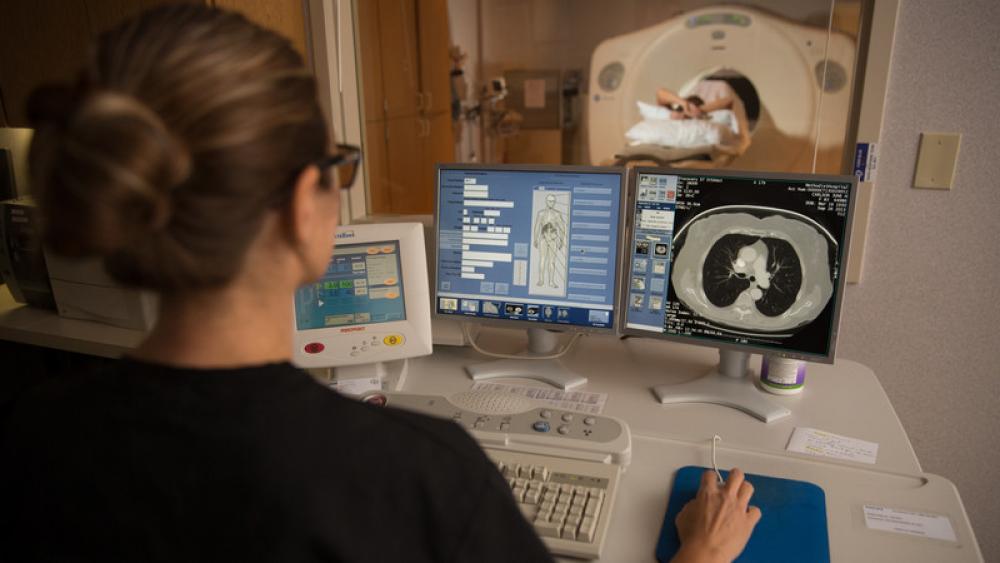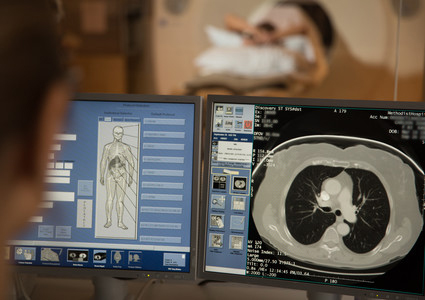




Cancer Care
Low-Dose Lung CT Scans Save Lives
Published: Nov. 12, 2020

Lung cancer is one of the most common types of cancer. It’s also one of the deadliest, accounting for nearly 25% of all cancer deaths. The American Cancer Society estimates that over 135,000 people will die from lung cancer this year. More people die as a result of lung cancer each year than from breast, colorectal and prostate cancer combined.
Despite these scary statistics, American Cancer Society researchers recently found that fewer than 4 percent of people who qualify for lung cancer screenings ever get them.
Screening for Lung Cancer
Low-dose computed tomography, or a low-dose CT scan, is the only recommended screening test for lung cancer. It’s the only way to find the earliest stages of the disease, when there are no outward signs or symptoms and the cure rate is high. The symptoms –cough and shortness of breath – don’t appear until the disease is advanced.
In 2013, the U.S. Preventive Services Task Force began recommending that certain people at high risk for lung cancer – mostly current and former smokers – have annual low-dose CT scans to screen for the disease. A recent study showed that if everyone eligible underwent screening, up to 12,000 lung cancer deaths a year could be prevented.
Read how a low-dose CT scan saved Gary Plog's life.
Lung Cancer Screening Guidelines
 You are eligible for lung cancer screening if you:
You are eligible for lung cancer screening if you:
- Are 55-77 years old
- Are asymptomatic (have no signs or symptoms of lung cancer)
- Smoke now or have quit within the past 15 years
- Have a 30 pack-year smoking history (one pack per day for 30 years or two packs a day for 15 years, etc.)
- Receive a written order for a low-dose CT scan from your medical provider
It’s important to note that the amount of radiation involved in a low-dose CT scan is very small and similar to that of an annual mammogram.
What Lung Screening May Find
A low-dose CT scan screens for abnormalities in the lungs that may be or become lung cancer. Nodules in the lungs could be an early sign of lung cancer, but not all nodules are.
Here in the Midwest, we have a lot of fungus in our soil, so nodules are extremely common. About 97 percent of the people we screen have nodules, and they’re benign.
Determining what’s serious and what’s not depends on a specific set of guidelines set forth by the International Early Lung Cancer Action Program. Those recommendations generally depend on the size of nodules and how they look. Patients may need to undergo additional testing, which could include a follow-up CT scan, a biopsy or a PET scan. Those tests will help determine if the diagnosis is cancer.
If a small lung nodule is found to be a cancerous, the cancer can be cured more than 80 percent of the time. This is why screening is so important.
How to Get a Low-Dose CT Scan
If you have a history of smoking, talk to your primary care provider about whether you should consider a low-dose CT scan. Your provider will discuss your options, the risks and recommendations.
For more information, about low-dose CT scan, contact the Methodist Estabrook Cancer Center Lung/Thoracic Oncology Clinic at (402) 354-5858, or the Methodist Jennie Edmundson Lung Mass Clinic at 712-396-7250.
Methodist has been a recognized lung cancer screening site since 2001 and was the first hospital in the region to participate in the I-ELCAP trial starting in 2006. Designated as a lung cancer screening center of excellence by the Lung Cancer Alliance, Methodist is one of only 250 such sites across the country.
More Resources
- Read how a low-dose CT scan saved Gary Plog's life.
- Learn about what to expect if you have a lung cancer diagnosis.
- Follow Methodist on Facebook, Instagram and Twitter for COVID-19 updates.


